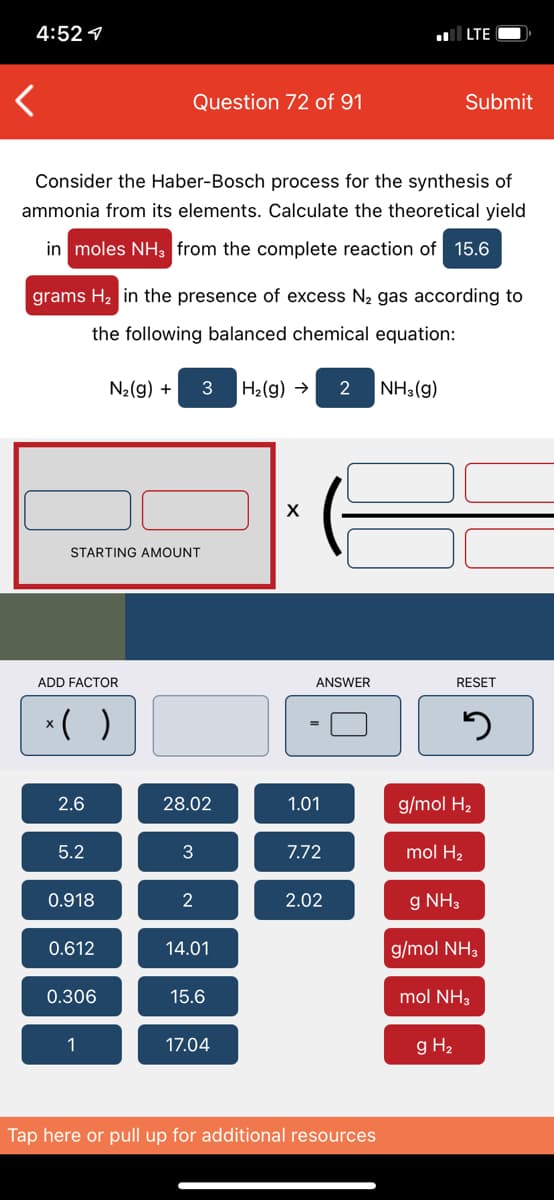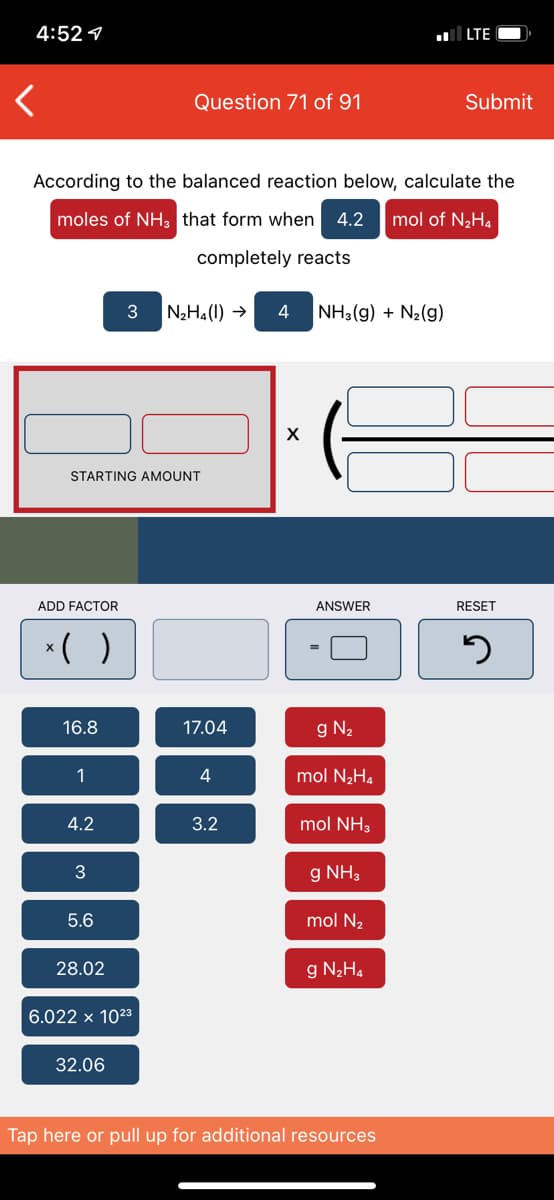Consider the Haber-Bosch process for the synthesis of ammonia from its elements. Calculate the theoretical yield in moles NH3 from the complete reaction of 15.6 grams H2 in the presence of excess N2 gas according to the following balanced chemical equation: N2(g) + 3 H2(g) → 2 NH3(g)
Consider the Haber-Bosch process for the synthesis of ammonia from its elements. Calculate the theoretical yield in moles NH3 from the complete reaction of 15.6 grams H2 in the presence of excess N2 gas according to the following balanced chemical equation: N2(g) + 3 H2(g) → 2 NH3(g)
Chemistry: Matter and Change
1st Edition
ISBN:9780078746376
Author:Dinah Zike, Laurel Dingrando, Nicholas Hainen, Cheryl Wistrom
Publisher:Dinah Zike, Laurel Dingrando, Nicholas Hainen, Cheryl Wistrom
Chapter11: Stoichiometry
Section: Chapter Questions
Problem 59A
Related questions
Question

Transcribed Image Text:4:52 1
LTE
Question 72 of 91
Submit
Consider the Haber-Bosch process for the synthesis of
ammonia from its elements. Calculate the theoretical yield
in moles NH3 from the complete reaction of 15.6
grams H2 in the presence of excess N2 gas according to
the following balanced chemical equation:
N2(g) +
H2(g) →
NH3(g)
STARTING AMOUNT
ADD FACTOR
ANSWER
RESET
*( )
2.6
28.02
1.01
g/mol H2
5.2
3
7.72
mol H2
0.918
2
2.02
g NH3
0.612
14.01
g/mol NH3
0.306
15.6
mol NH3
1
17.04
g H2
Tap here or pull up for additional resources

Transcribed Image Text:4:52 1
LTE
Question 71 of 91
Submit
According to the balanced reaction below, calculate the
moles of NH3 that form when
4.2
mol of N2H4
completely reacts
3
N2H4(1) →
4
NH3(g) + N2(g)
STARTING AMOUNT
ADD FACTOR
ANSWER
RESET
*( )
16.8
17.04
g N2
1
mol N2H.
4.2
3.2
mol NH3
g NH3
5.6
mol N2
28.02
g N2H4
6.022 x 1023
32.06
Tap here or pull up for additional resources
Expert Solution
This question has been solved!
Explore an expertly crafted, step-by-step solution for a thorough understanding of key concepts.
This is a popular solution!
Trending now
This is a popular solution!
Step by step
Solved in 3 steps with 2 images

Knowledge Booster
Learn more about
Need a deep-dive on the concept behind this application? Look no further. Learn more about this topic, chemistry and related others by exploring similar questions and additional content below.Recommended textbooks for you

Chemistry: Matter and Change
Chemistry
ISBN:
9780078746376
Author:
Dinah Zike, Laurel Dingrando, Nicholas Hainen, Cheryl Wistrom
Publisher:
Glencoe/McGraw-Hill School Pub Co

Chemistry for Engineering Students
Chemistry
ISBN:
9781337398909
Author:
Lawrence S. Brown, Tom Holme
Publisher:
Cengage Learning

Chemistry: An Atoms First Approach
Chemistry
ISBN:
9781305079243
Author:
Steven S. Zumdahl, Susan A. Zumdahl
Publisher:
Cengage Learning

Chemistry: Matter and Change
Chemistry
ISBN:
9780078746376
Author:
Dinah Zike, Laurel Dingrando, Nicholas Hainen, Cheryl Wistrom
Publisher:
Glencoe/McGraw-Hill School Pub Co

Chemistry for Engineering Students
Chemistry
ISBN:
9781337398909
Author:
Lawrence S. Brown, Tom Holme
Publisher:
Cengage Learning

Chemistry: An Atoms First Approach
Chemistry
ISBN:
9781305079243
Author:
Steven S. Zumdahl, Susan A. Zumdahl
Publisher:
Cengage Learning

Chemistry: The Molecular Science
Chemistry
ISBN:
9781285199047
Author:
John W. Moore, Conrad L. Stanitski
Publisher:
Cengage Learning

Chemistry & Chemical Reactivity
Chemistry
ISBN:
9781133949640
Author:
John C. Kotz, Paul M. Treichel, John Townsend, David Treichel
Publisher:
Cengage Learning

Chemistry & Chemical Reactivity
Chemistry
ISBN:
9781337399074
Author:
John C. Kotz, Paul M. Treichel, John Townsend, David Treichel
Publisher:
Cengage Learning